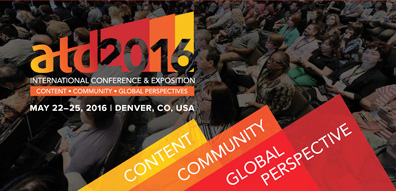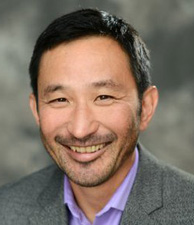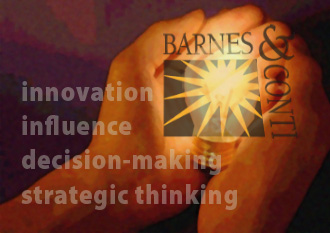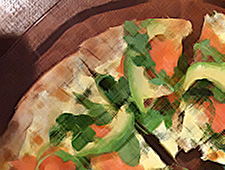
Unable to view in email? Read the newsletter online.
How to Uncover Great Ideas and Develop Talent: 3 Simple Rules for Innovation Leaders (or Parents)
B. Kim Barnes
 Sometimes doing what comes naturally doesn’t achieve the results you hope for. Sometimes what we learn as best practices aren’t. Do any of these situations sound familiar?
Sometimes doing what comes naturally doesn’t achieve the results you hope for. Sometimes what we learn as best practices aren’t. Do any of these situations sound familiar?
- In a team meeting, your newest employee tentatively puts an idea forward. You think it’s very promising and you want to encourage him or her, so you praise the idea and the employee.
- You’ve just heard an idea from one of your team members. It resonates with you and you immediately begin to build on it, adding your own thoughts to develop it further.
- Your young child shows you a drawing. You’re very busy, but you take a moment to admire it and comment on his or her artistic talent, then put the work up for display.
So, what’s the problem here? We’ve learned as leaders and parents how important it is to encourage and provide positive feedback. Except… in each of the situations above, you’ve done something that stops the creative process cold.
In the first instance, there can be an impact both on the individual and the team. Praising an idea too early can stop the ideation process for the originator (I guess it’s good enough if the boss likes it) and others on the team may refrain from putting out their ideas, especially if they’re very different from the one that was approved by the leader.
In the second situation, the idea may become yours. Often, a more junior team member will hesitate to build on, improve, and take responsibility for implementing an idea once that idea has been altered and “improved” by his or her manager.
In the third example, your child may learn to distrust your praise once he or she sees drawing by peers that are clearly better. This may discourage further creative efforts or, alternatively, create a dependency on parental admiration, making it less likely that he or she will “color outside the lines” and try something really new.
So, how can you intervene in a way that encourages team members or progeny to be creative and to move interesting ideas into action?
For many years, I have followed three rules during the early phases of the creative process—I’m not sure where I learned them, but they have proven to be highly valuable when I remember to use them! They are focus, attention and acceptance.
Focus:
Keep your focus on the other person. Rather than “improving” his or her idea, encourage him or her to tell you more about it. Ask for his or her rationale or examples of how the idea might work. Be curious, not challenging at this phase. Listen actively to key points without trying to change the meaning or add your own embellishments. This can help the other to think through the idea while maintaining ownership of it.
Attention:
Even the quietest person on your team can enjoy developing an idea out loud in a thoughtful way if he or she isn’t rushed or interrupted. Having the full, even rapt attention of others—especially people we admire and respect—can create a sense of one’s value to the group. Treating someone as the most interesting person in the room benefits both you and the other – you may actually learn something, and he or she will think you are a brilliant conversationalist.
Acceptance:
It’s too easy to substitute judgment—either positive or negative—for thoughtful consideration and interest in another’s idea. I think most of us have learned to suspend criticism early in the life of an ideation process, but what about positive feedback? This, too, can cut creative thinking short and as a leader, praising an idea too early may unintentionally signal what the politically correct response should be, thereby limiting the scope of ideas that are generated.
Of course, all of these behaviors—building on, improving, and evaluating ideas—will be useful once you have a broad and diverse range of options.
Oh, and that drawing? Put down your phone and ask your child to tell you all about it. Your focus, attention, and acceptance can lead you both to new and interesting places.
ATD... Here We Come!

We are excited to be part of ATD again this year. Nelson Soken, our Chief Innovation Strategist, will be speaking and participating in a panel discussion during the Healthcare Lunch & Learn on Sunday, May 22 from 11:00 am -1:30 pm. He will be discussing how an understanding of human cognition and behavior can help organizations transform healthcare. Check out this link for more information. Also, be sure to read his recently posted blog about the impact of cognition and behavior on healthcare on the ATD website (an excerpt follows).
Barnes & Conti will also be exhibiting at the ATD Expo in Denver. Nelson (Monday, May 23 only), Eric Beckman and Janne Rochlin will be at Booth #1201 and are looking forward to seeing you! For more information and some product previews and articles, go to the ATD website.
Understanding of Human Cognition and Behavior Can Help Transform Healthcare (excerpt)
Nelson Soken, PhD, Barnes & Conti’s Chief Innovation Strategist
The U.S. healthcare system is undergoing rapid transformation, from a payment system that is fee-for-service to a patient outcome-based model that includes incorporating patient satisfaction, as evidenced by the HCAHPS: Hospital Consumer Assessment of Healthcare Providers and Systems survey.
For hospital systems to survive and thrive in this new landscape, they need to adapt and innovate how they deliver healthcare. The challenge is that humans, at both the individual and group level, resist change. Indeed, a plethora of evidence demonstrates that people generally defend the status quo, avoiding chaos and disruption—especially when there has been a well-established status quo. Innovation always initiates change, the consequences of change are usually uncertain, and uncertainty breeds fear. This fear creates significant barriers for new ways of operating.
What will it take for healthcare organizations to overcome this resistance? The answer lies in understanding human psychology...
Continued on the ATD Website
 Spotlight on Nelson Soken, Chief Innovation Strategist
Spotlight on Nelson Soken, Chief Innovation Strategist
Nelson has over 20 years of corporate experience in a variety of leadership, managerial, program management, strategy, and technical roles with Honeywell International and Medtronic. As a consultant, Dr. Soken has clients such as the Mayo Clinic, Medtronic, PARC, and Andamio Games working on innovation and design thinking projects. Nelson has conducted innovation, strategic thinking, risk-taking and decision-making workshops across the United States, Europe, and Canada for Fortune 500 companies and universities. He co-authored a book, Lead the Pack: Sparking Innovation That Drives Customers Wild. In addition to Nelson’s consulting work, he has been a sought after speaker on the conference circuit. Some of his recent past talks included:
- DMI (Design Management Institute) 2015 Conference: Innovation Barrier Buster
- DMI Webinar 2015: Buried in Busyness: Designing Your Way to a Seat at the Strategic Table
- HR West Workshop: Intelligent Risk-Taking and Decision-Making
- ScrumDays Twin Cities 2014: Scrum: How Honing Your Perceptual and Cognitive Mindset will Deliver Big Results!
- MedStar Institute for Innovation 2014: Innovation Thru Inspiration: Breaking Away from Our Own Cognitive Biases
If you are interested in reading more about innovation and psychology of innovation, see the following article that he and Kim Barnes wrote a few years ago: “What Kills Innovation? Your Role as a Leader in Supporting an Innovative Culture.”
Please let us know if you would like to have a brief chat with Nelson about innovation challenges in your organization.
Exciting Work Continues:
 We
are thrilled to welcome some new customers, excited to work on interesting
projects, and delighted to continue to meet the needs of our valued
existing clients. Here are some examples of 2016 projects that are keeping
us busy this first half of the year:
We
are thrilled to welcome some new customers, excited to work on interesting
projects, and delighted to continue to meet the needs of our valued
existing clients. Here are some examples of 2016 projects that are keeping
us busy this first half of the year:
- Developed a comprehensive, custom Innovation Learning Journey for a leading global pharmaceutical company. Designed by B. Kim Barnes and Nelson Soken, it uses Managing Innovation™ as the starting point. The journey includes sponsor and management engagement activities and a webinar on the front-end—an experiential two-day session where best practices and latest innovation research for building leadership skills and a conducive culture for innovation are shared and applied to an action-learning project—and follow up, cohort activities are held on the back-end to continue work on important projects as part of the immersive learning design. An innovation app to be used on a mobile device is under development to reinforce learning. Following a successful walk-though and pilot, these sessions will be facilitated by our global partners in local language throughout the world beginning in June.
- Designed a custom Strategic Decision-Making program with sessions being held in Europe and in the US for a growing biotech company.
- Worked with the legal group of a large technology-based manufacturing company on fine-tuning their internal consulting skills as they provide legal support to their internal stakeholders; also developed a custom Exercising Influence™ program as part of a peer-coaching initiative.
- Conducted a custom influence program to help a trade association develop better relationships with their member organizations.
- Worked with the Strategy Group of a healthcare organization to help them influence cross-functionally and upwards.
- Continued Strategic Thinking™ and Exercising Influence™ workshops for technology, pharmaceutical, medical device, manufacturing, chemical, healthcare, and higher education industries globally.
- Implemented Exercising Influence Virtual sessions for a banking and healthcare organization.
- Certified another group of facilitators working for a large university system in Exercising Influence™ to support internal delivery campus-wide.
- Continued coaching several individuals focused on personal and leadership effectiveness and onboarding teams.
- Supported our Saudi Arabian partner’s new business with a large banking institution who will be implementing Art of Communication™ and Constructive Negotiation™. Translations into Arabic are underway!

“Wisteria,” photo by B. Kim Barnes
Like our newsletter?
For more valuable information and special offers, follow us!
In this Issue:
- “How to Uncover Great Ideas and Develop Talent: 3 Simple Rules
for Innovation Leaders (or Parents)“
B. Kim Barnes - ATD... Here We Come!
- “Understanding of Human Cognition
and Behavior Can Help Transform Healthcare” (excerpt)
Nelson Soken, PhD - Spotlight on Nelson Soken, Chief Innovation Strategist
- Updates: Exciting Work Continues
- Featured Art: “Bust of a Child,” by Paul Klee
- Featured Photo: “Wisteria,” by B. Kim Barnes
- Recipes for Spring:
- Smoked Salmon Pizza
- Quinoa Salad with Artichokes
Exercising Influence Public Program
Exercising Influence on May 17 in Berkeley, CA will help you build the relationships necessary to get positive results up, down, and across your organization.
Additional Exercising Influence offerings are available on the following dates:
- July 19, 2016
- October 18, 2015
Cost: $795
Click here to register.
If you can't attend either of the programs listed above, Kim Barnes will be facilitating Exercising Influence at the ATD Golden Gate Chapter in Oakland, CA on June 7.
See the ATD Golden Gate Chapter website for details.
Recipes for Spring
Smoked Salmon Pizza

Lauren Powers, SVP of Business Development says, “If you leave Easter Brunch to the one Jewish family member, this is what you get…a pizza with nova lox!”
“We recently had a great Easter celebration over brunch to accommodate everyone’s travel schedules. Of course, a requisite ham was required but the brunchier dishes were a lot more fun to plan and prepare….blintz soufflé, spanakopita, strawberry salad, potato tortilla and asparagus tortillas, sour cream coffee cake, pound cake, banana chocolate chip cake, and what proved to be the favorite….smoked salmon pizza. Who needs a bagel?”
“If you are making for brunch, make sure to serve it with ample mimosas using freshly squeezed orange juice… yum!”
Ingredients:
- One large store-bought pizza/flatbread crust (Whole Foods has a good one)
- 1 8 oz package of cream cheese, softened
- 1 bunch of scallions, chopped
- 1 egg yolk
- Splash of Worcestershire sauce
- 1/4 lb smoked nova salmon, thinly sliced
- Handful of arugula
- 6-8 slices of avocado
- 1-2 tbsp fresh dill, chopped
Method:
- Preheat oven to 450 degrees.
- Soften cream cheese in microwave and whip.
- Add egg yolk, scallions, and Worcestershire sauce.
- Spread cheese mixture on pizza shell.
- Bake for 10-15 minutes until crust is brown and cheese is golden.
- Add slices of salmon to cover pizza.
- Add chopped dill and arugula on top of salmon.
- Slice pie and place one piece of avocado over each slice.
Quinoa Salad with Artichokes

Here’s a taste of spring in a simple recipe from the collection of Kim Barnes. This serves 4 as a side dish or appetizer.
Ingredients:
- 1 tbsp olive oil
- 1 cup chopped spring or sweet onion
- 1/2 tsp chopped fresh thyme
- 1 (9-ounce) package frozen artichoke hearts, thawed
- 1 cup fat-free, lower-sodium chicken broth
- 1/2 cup uncooked quinoa
- 1 cup chopped fresh parsley
- 5 teaspoons grated lemon rind
- 1 1/2 tablespoons fresh lemon juice
- 1/4 teaspoon kosher salt
Method:
- Heat oil in a medium saucepan over medium-high heat.
- Add onion and thyme; sauté 5 minutes or until onion is tender.
- Add artichokes; sauté 2 minutes or until thoroughly heated.
- Add broth and quinoa; bring to a simmer.
- Cover and cook 18 minutes or until liquid is completely absorbed.
- Remove pan from heat. Stir in parsley, rind, juice, and salt.
Serve warm or at room temperature.
You are receiving these emails from Barnes & Conti because you are a client, colleague, and/or friend of Barnes & Conti Associates. or you contacted us through our website, at a trade show, or via social media. Barnes & Conti does not sell, trade, or give away mailing lists or email addresses to anyone. Period.
If you no longer wish to receive these bulletins, use this link to unsubscribe or write us at Barnes & Conti, 940 Dwight Way Suite 15, Berkeley, CA 94710.
*Please don't forward this entire email; the person you forward to might inadvertently unsubscribe you with the above link!
